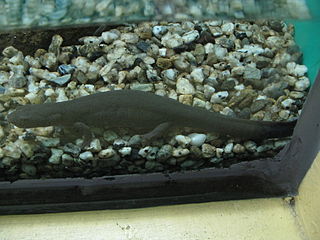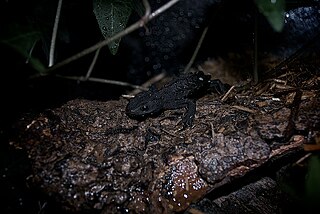
The palmate newt is a species of newt found in Western Europe, from Great Britain to the northern Iberian peninsula. It is 5–9.5 cm (2.0–3.7 in) long and olive or brown with some dark spots. The underside is yellow to orange, and the throat, unlike in the similar smooth newt, always unspotted. A dark stripe runs along the head and through the eyes. Breeding males develop a distinct filament on the end of their tail, strongly webbed hind feet, and a low, smooth crest on their back.

Salamandridae is a family of salamanders consisting of true salamanders and newts. Salamandrids are distinguished from other salamanders by the lack of rib or costal grooves along the sides of their bodies and by their rough skin. Their skin is very granular because of the number of poison glands. They also lack nasolabial grooves. Most species of Salamandridae have moveable eyelids but lack lacrimal glands.

Paramesotriton labiatus is a species of newt in the family Salamandridae. It is endemic to Guangxi, China. In literature prior to 2011, this species may have been confused with Paramesotriton chinensis, Pachytriton granulosus, or Paramesotriton ermizhaoi. This species has several vernacular names, including Unterstein's newt, spotless stout newt, spotless smooth warty newt, Zhao Ermi's smooth warty newt, and paddletail newt.

The Hong Kong warty newt or Hong Kong newt is a species of salamander found in Hong Kong. Once thought to be endemic to the territory, the species has also been found in the coastal parts of Guangdong Province. It is the only Urodela living in Hong Kong.

Tylototriton verrucosus is a species of newt found in the Indian subcontinent and Southeast Asia. Common names include: Himalayan newt, crocodile newt, crocodile salamander, Himalayan salamander, red knobby newt.
The Dayang newt is a rare species of salamander in the family Salamandridae, endemic to China. It is known from Jiexi County in eastern Guangdong from where it was collected in 1936 and described as a new species in 1983. More recently, it has also been found from Dehua County in central Fujian.

Anderson's crocodile newt, Anderson's newt, Ryukyu spiny newt, or Japanese warty newt is a species of salamander in the family Salamandridae found in the Ryukyu Islands of Japan, and, at least formerly, Mount Guanyin in northern Taiwan, where it is now believed to be extinct.
Neurergus crocatus, the yellow-spotted newt, Azerbaijan newt, Azerbaijan mountain newt, mountain newt, or Lake Urmia newt, is a species of salamander in the family Salamandridae. It occurs in the mountains west of Lake Urmia, in northwestern Iran, northeastern Iraq, and southeastern Turkey.
The spot-tailed warty newt is a species of salamander in the family Salamandridae only found in central China. Its natural habitats are subtropical or tropical moist lowland forests and rivers. It is threatened by habitat loss. Female spot-tailed warty newts reach a total length of 155 mm (6.1 in), males are slightly shorter.

Paramesotriton, also known as warty newts or Asian warty newts, is a genus of salamanders in the family Salamandridae. The genus is found in southwestern and southern China and in northern Vietnam. Most of the species are endemic to China, and the majority of them have been described recently, since 2008. The genus includes both pond and stream dwellers.

The Chinese warty newt is a species of salamander in the family Salamandridae. It is found only in China, with a range extending from Chongqing to Hunan, Anhui, Zhejiang, Fujian, Guangdong, and Guangxi Provinces in Central China. Its natural habitats are subtropical or tropical moist lowland forests, rivers, and freshwater marshes. It is threatened by habitat loss. Female Chinese warty newts reach total length of 151 mm (5.9 in), males are slightly shorter.

The Algerian ribbed newt is a species of salamander in the family Salamandridae found in Algeria and Tunisia. The natural habitats of this newt are rivers, intermittent rivers, swamps, cisterns, freshwater marshes, intermittent freshwater marshes, and ponds. It is threatened by habitat destruction.

The Carpathian newt, or Montandon’s newt, is a species of salamander in the family Salamandridae found in Czech Republic, Poland, Romania, Slovakia, and Ukraine.

The Wenxian knobby newt or Wenxian knobby salamander is a species of salamander in the family Salamandridae. It is endemic to central China. Its type locality is Wen County in Gansu, or in Chinese: 文县; pinyin: Wénxiàn, hence the name.
The Fuding fire belly newt is a rare species of newt in the family Salamandridae, endemic to China. It is only known from Fuding in northeastern Fujian, from the locality where it was described as a new species in 2010. Although it is genetically similar to the Chinese fire belly newt, it is morphologically more similar to the Dayang fire belly newt. The range of C. fudingensis is separate from both other species.

Tylototriton ziegleri, also known as Ziegler's crocodile newt or Ziegler's knobby newt, is a species of newt in the family Salamandridae. It is currently known from Hà Giang and Cao Bằng provinces in northern Vietnam, although its actual range probably wider; there is a photograph to suggest it also occurs in Lào Cai Province in Vietnam, and its range likely extends to Yunnan in southern China. Based on molecular genetic data, Tylototriton ziegleri belongs to the "Tylototriton asperrimus group" of newts. The specific name ziegleri honours Thomas Ziegler, a German herpetologist.
Paramesotriton maolanensis, also known as the Maolan warty newt, is a species of salamander in the family Salamandridae. It is known only from Maolan National Nature Reserve in Libo County, southern Guizhou, China. It is a relatively large member of its genus, reaching a total length of about 21 cm (8.3 in). All know specimens were collected from a deep pool, but the species probably lives in underground rivers too, that is, it is stygobitic.

Tylototriton himalayanus is a species of salamander in the family Salamandridae. It is known from the Ilam District in eastern Nepal, Darjeeling in northwestern India, and western Bhutan. It is one of the only two species of salamanders found in India.

The angular-headed newt, also known as angular-headed crocodile newt, is a species of salamander in the family Salamandridae from Thailand, Laos, and Vietnam. Its unique orange markings help to distinguish it from other species, and also gave it the nickname "Star-Trek newt", as it resembles the ridges on the head of the fictional Klingon species from the television show Star Trek.
Pachytriton inexpectatus is a species of salamander in the family Salamandridae. It is endemic to southern China and found in the Guizhou, Hunan, Guangdong, and Guangxi provinces. Its type locality is Mount Dayao of Jinxiu Yao Autonomous County, Guangxi. Prior to naming of this species in 2011, it was confused with Pachytriton labiatus. It is one of the several species that can appear in the pet trade as paddletail newt. The specific name inexpectatus is Latin meaning "unexpected" and refers to finding a species that is common in pet trade but lacked formal scientific description. Common name Yaoshan stout newt has been coined specifically for this species.














